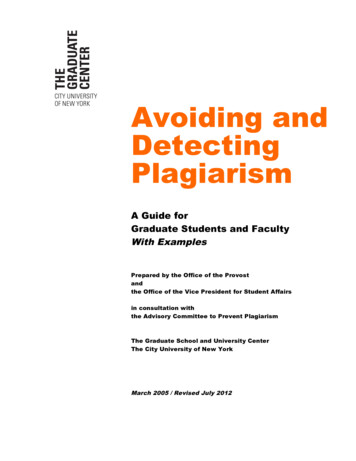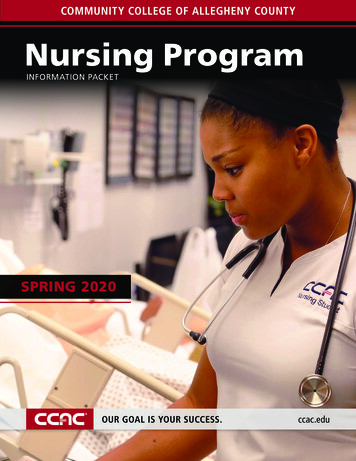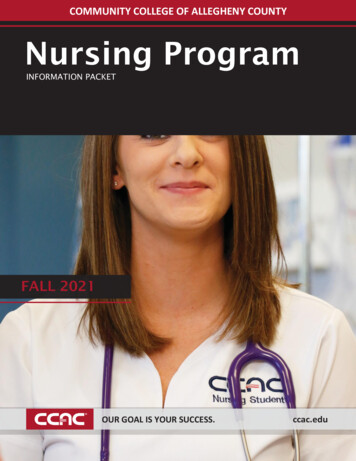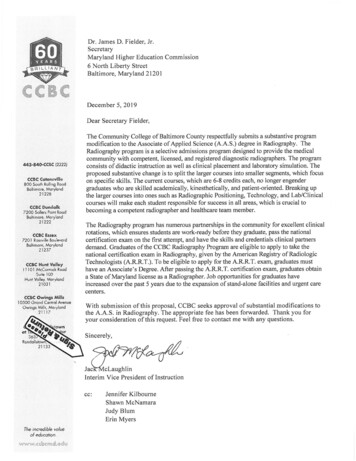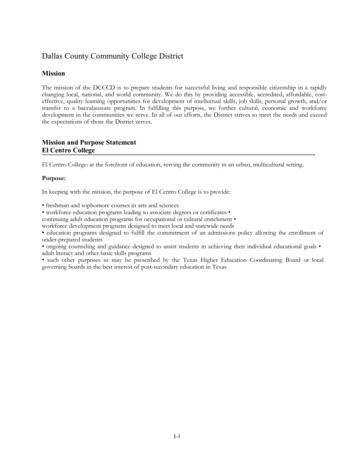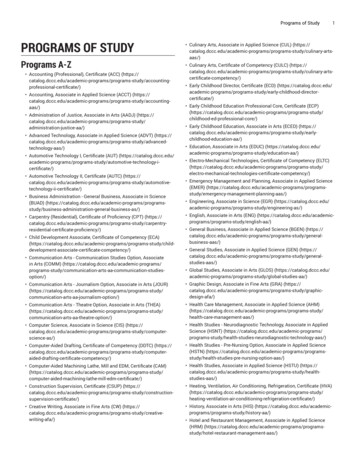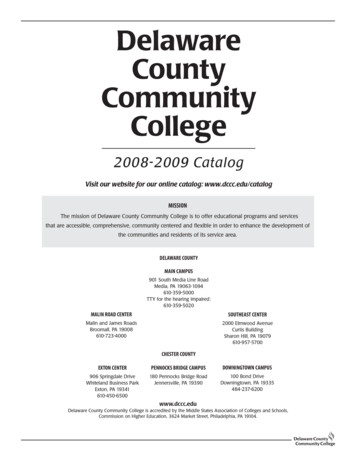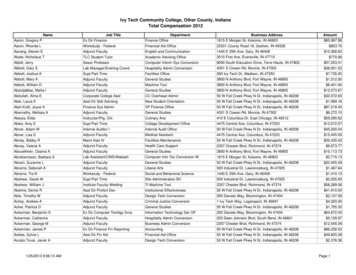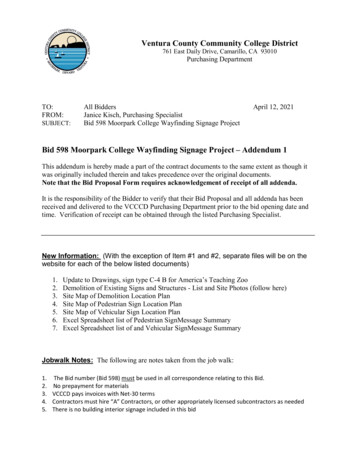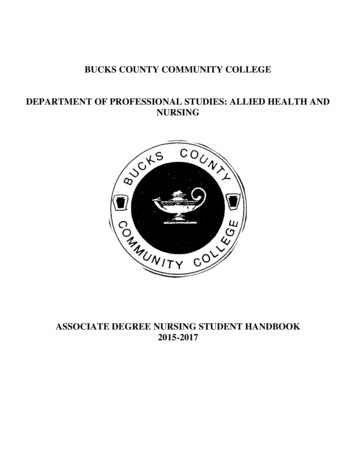
Transcription
BUCKS COUNTY COMMUNITY COLLEGEDEPARTMENT OF PROFESSIONAL STUDIES: ALLIED HEALTH ANDNURSINGASSOCIATE DEGREE NURSING STUDENT HANDBOOK2015-2017
Table of ContentsThe Community’s CollegeVision, Mission, Core Values, and Institutional Goals .The Nursing Program.History & Accreditation Status .Philosophy .Organizing Structure Program Outcomes Program Outcome Evaluation Functional Abilities Nursing Program of Study .Course SyllabiNURS 101 NURS 102 NURS 201 NURS 202 Gordon’s Functional Health Patterns with Nursing Diagnosis .PoliciesAdvanced Placement Attendance Lateness .Make-up .Biohazard Safety .Confidentiality Confidentiality Statement .Grievance .Health Policy . .Health RecordPhysical Examination Form .Immunization Record . .Tuberculin Skin Testing Administration Record .Flu Vaccine Documentation .Dental Examination .Student Profile Health Insurance Health Risk Waiver .Hepatitis B Vaccine Declination Integrity .Latex Free .Protection From Latex Exposure 46474849505253
Professional Attire .Professional Behavior Criminal Record Clearances Drug Screens Student Patient RelationshipsDocumentation Protecting Patient Rights/ Nurse’s Responsibilities .Medication Administration .Social Media CPR .Professional Liability Insurance .Smoking Clinical Responsibilities Statement .Malpractice Liability Insurance Statement .Readmission to Clinical Component Student RecordsStudent Record Review and Audit Permission Testing and GradingTesting .Missed Test/Examinations Clinical Evaluations .Clinical Grades/Progression Requirements .Incomplete Grades .Withdrawal/ Failures . .Repeating a Nursing Course .Psychomotor Skills .Grade Appeal Student Services:Advising Nursing Faculty . Articulation Planning Counseling & Career Center .Bookstore . .Learning Resources.Library . .Tutoring Center .On-Line Learning Help .‘The Hub’Admissions, Registration, & Records .Financial Aid . 696971717171727272727373
Scholarships .Student Accounts .Fees for Nursing Student Oriented ActivitiesStudent Representation on Committees Nursing Club .Nursing Recognition, The Pinning Ceremony . By-Laws: Nursing Club . . .Student Handbook Acknowledgement . . .Approved: 7/98Reviewed: 9/99, 9/00, 9/01, 10/01, 8/03, 8/05, 8/06, 8/08, 08/09,08/10, 08/11,05/14Revised: 05/13Target Date: YearlyBy: Director/Faculty47373747575757679
BUCKS COUNTY COMMUNITY COLLEGETHE COMMUNITY’S COLLEGEI. VisionWe envision Bucks County Community College as a vibrant center for community engagement and learning,providing innovative paths that inspire educational, career, and personal fulfillment.II. MissionBucks County Community College provides a diverse community of learners with exemplary, accessibleeducational opportunities and the personal connections that foster success.III. To support the mission, we: Engage and support students in learning experiences that lead to academic excellence andprovide a foundation for the pursuit of higher degrees and lifelong learning. Develop the critical thinking skills, broad-based knowledge, and the social, ethical, andcivic responsibility of our students. Enrich the intellectual, cultural, and recreational life of the community.5
BUCKS COUNTY COMMUNITY COLLEGENURSING PROGRAMWelcome to the Associate Degree Nursing Program at Bucks County Community College.Historical PerspectiveAssociate Degree Nursing (ADN) is in its 60th year, since its inception and implementation by Dr. MildredMontag, Teachers College, and Columbia University. ADN programs were developed and based on manypremises, still demonstrated today by Bucks County Community College AD Nursing Program.o The function of nursing can and should be differentiated These functions lie along a continuum, at points on the continuum, the functions mayoverlap and the roles of nurses come very close.o Courses in the curriculum include general education courses, that supporting nursing principles,one half of the curriculum are nursing courses.o Content is grouped into broad areas that reflect nursing practice concepts.o A variety of clinical agencies are used to promote learning. One hospital or health agency is notsufficient to meet the learning needs of the student. .o Learning experiences are planned for the clinical area. The college nursing faculty areresponsible for developing the curriculum and for teaching the students. The nursing faculty isemployed by the college and with the same privileges and obligations as other faculty members.o College admission and graduation requirements are met by the student.o An associate degree is granted by the institution upon completion of the entire program of study.o The graduate is eligible for the licensing examination of the state in which the college is arly History of Associate Degree Nursing.pdfIn 1967-1968, Bucks County Community College conducted a study to evaluate the community’s needs forfuture educational programs. The outcome of this study indicated a need for a program in nursing.Further support came from recommendations made by the Middle Atlantic States Evaluation Committee. TheBucks County Community College’s Board of Trustees reviewed the recommendations and voted to endorse anursing program. In 1969, 33 students enrolled in the first class. Since the inception of the program 3,400students have graduated from Bucks County Community College’s Associate Degree Nursing Program.Accreditation StatusBucks County Community College is fully accredited by the Middle States Association of Colleges andSecondary Schools. The College is also an approved institution of higher education in Pennsylvania by theDepartment of Education of the Commonwealth. Current NCLEX-RN success rates are available pen 514&objID 572050&mode 2The Associate Degree Nursing Program is fully approved by the Pennsylvania State Board of Nursing and isaccredited by the Accreditation Commission for Education in Nursing (ACEN) known in the past as theNational League for Nursing Accrediting Commission located at 3343 Peachtree Road, NE, Suite 850, AtlantaGeorgia 30326.6
PHILOSOPHYThe philosophy of the Nursing Program is consistent with the core values and mission of the College. Weaffirmatively recruit and provide assistance to students from all racial, ethnic, cultural, and economicbackgrounds. We subscribe to the College’s definition of an educated person. Our purpose is to preparestudents for entry-level registered nurse positions.The program of study meets the requirements of the Associate of Arts degree and the nursing graduates areeligible to sit for the National Council Licensure Examination for Registered Nurses. (NCLEX-RN)Recognizing the dignity and worth of all human beings that deserve respect, we believe that:INDIVIDUALS are unique beings with needs, possessing their own value systems, and have the right to makedecisions concerning their health care for the purpose of reaching their optimum state of health and wellness.NURSING is the art and science of caring for and about individuals. Nurses are advocates on behalf ofindividuals when they are vulnerable to alterations within their environment. Nurses utilize the nursing processto diagnose and treat responses to actual and potential health problems and alleviate suffering.1EDUCATION is a continuous process of growth resulting in measurable changes in the learner’s behavior.Learning is a highly individual experience that takes place in a variety of settings and proceeds at differentrates.ASSOCIATE DEGREE NURSING EDUCATION should be an integral part of the system of highereducation. To that end, our course sequence is designed to provide an integrated education in the sciences andthe humanities. Further, our Associate Degree Nursing Program proceeds from less complex to more complexin a related organized sequence of learning objectives. These objectives correlate theory with clinical practiceusing a wide variety of learning experiences. The program develops caring, critical thinking, and inquiringstudents ready to grow and serve society as nurses and citizens.ASSOCIATE DEGREE GRADUATES use critical thinking and clinical judgment in the practice of nursingand are accountable as direct care providers in settings where patients experience problems that are common tothe general population. Nursing practice is defined through the roles of provider of care, manager of care, andmember within the discipline. The graduates are skilled in the use of the nursing process in caring for thehealth-care consumer. They direct less prepared health care providers and are directed by more experiencedand/or professional nurses.The ultimate responsibility, and first priority, of the nursing faculty is to assure the health-care consumer thatour graduates are safe, competent, and caring practitioners.Adopted: 5/99Every 5 years: JanuaryReviewed: 09/04; 05/13FacultyRevised: 05/081American Nurses Association Social Policy Statement, 2003.7
Organizing StructureThe Nursing Faculty at Bucks County Community College conceives that the notion of nursing as an art and science ofcaring. Caring includes five concepts. They are: AWARENESS, KNOWLEDGE, INTENTION, POSITIVE CHANGE,and CRITERION WELFARE.2 These caring concepts reflect a nurturing concern for individuals as they respond toalterations in their environments.NURSING is a learned skill, requiring a high degree of AWARENESS that an individual has an alteration in their needsand assistance is required, a KNOWLEDGE of nursing principles that can assist an individual’s response while guidingone’s action, a strong INTENTION to assist the individual to effect POSITIVE CHANGES in the individual’s responsethrough the utilization of the nursing process.KNOWLEDGE of nursing principles that can assist an individual is imperative. The nurse must have a strongINTENTION of caring to be able to assist the individual in a POSITIVE CHANGE. It also reflects, in this larger context,a more generalized CRITERION that is consideration for an individual’s welfare and human dignity, when this individualis to be in a vulnerable state.However; there is a caveat in that wellness must not be defined solely by the health care provider, but must be seen as apartnership between individuals in need of care and the health care team, of whom the Associate Degree Nurse is anintegral part. To that end, the science of caring is reflected in a systematic use of nursing knowledge through the nursingprocess. The art of caring applies the nursing process in a manner that engenders respect for the uniqueness of eachindividual and that values human dignity and worth.CARING is evidenced by touch, trust, nurturance, empathy, and compassion. Individuals are the center of nurses’ caring.In order to teach caring attitudes and activities, the program of study presents essential concepts as a recurring themewhich increases in complexity. The caring concepts flow outward from and encircle the individual.The individual has needs which may be affected by alterations in the internal or external environment. These needs arecategorized into Functional Health Patterns. The alterations in these Functional Health Patterns are approached by usingcommon heath problem prototypes. When an individual has an alteration in his/her needs, they may respond to thesealterations effectively, potentially ineffectively, or ineffectively. Therefore, nursing must be a force acting on their behalfwhen the individual is vulnerable to an alteration in his/her environment and unable to adapt.Roles Of The NurseUsing nursing knowledge and the nursing process, the nurse functions in three designated roles to fulfill caring behaviorsand activities. Therefore, caring is a mediated action accomplished through the three roles: Provider of Care, Manager ofCare, and Member within the Discipline.The program of study progresses through four nursing courses, which initially introduce these concepts, then applies themin concurrent laboratory and clinical experiences that build in complexity. Cognitive, affective, and psychomotor skills2Gaut, D. “Development of a theoretically adequate description of caring”. Western Journal of Nursing Research; Fall 1983.8
related to individuals’ health patterns and the three responses to alterations are applied to patients of all ages and stages ofdevelopment. Initially dealing with singular and advancing to those, which are multifaceted problems.Program Outcomes or Student Educational OutcomesThe Bucks County Community College graduate will practice the three Associate Degree Nursing roles in a safe,competent, and caring manner. The graduate nurse will use critical thinking to apply the theoretical knowledge from thecognitive, affective and psychomotor domains to:1.Communicate in a professional manner that acknowledges and preserves the individual’s dignity andworth, while recognizing cultural differences.2.Apply the nursing process to diagnose and treat individual and family responses to alterations in theirfunctional health patterns.3.Collaborate with the health care team to manage groups of patients with predictable outcomes whileappropriately delegating duties to other health care providers.4.Demonstrate awareness of today’s health care delivery system and its impact on future health, actaccording to and within the legal and the ethical standards set forth by the Pennsylvania Nurse PracticeAct, the College, the Nursing Program, the legal-system at large, the affiliating agency, and the agenciesaccreditation bodies.Program Outcome Evaluation:1.First-time candidates will achieve a pass rate at or above the national mean on the NCLEX-RN.2. Seventy percent (70%) of the students who enter Nursing I will graduate in two years.3. Eighty percent (80%) of graduating students report program satisfaction.4. Eighty percent (80%) of the graduates seeking employment will obtain an entry-level position within six (6)months after graduation.5. Seventy percent (70%) of the employers report satisfaction with graduate performance.6. Articulation agreements are in place with Colleges/Universities (BSN Programs).Adopted: 5/99Reviewed: 09/04, 5/08, 9/09, 05/12, 05/149
Bucks County Community CollegeDepartment of Professional Studies: Allied Health and NursingAssociate Degree Nursing ProgramFunctional Abilities ListBucks County Community College AD Nursing program is committed to students achieving their educational goals in asafe environment for students and patients alike. The following are considered functional abilities necessary for allstudents to safely complete the Program Outcomes, provide patient care, and practice nursing. If students believe they arenot able to perform one or more of these activities, the student should discuss this with their instructor, or the Director ofAssociate Degree Nursing. If a student is aware of a disability that may be affecting the ability to meet the functionalabilities, the student is encouraged to self identify to the Office of disAbility Services. The college is committed toprovide reasonable accommodations for otherwise qualified students with a disability. The AD nursing program andvarious campus resources, including the Office of disAbility Services, will work with the student to provide a safe optimallearning environment.Functional abilities are physical and mental activities and attributes needed by a nurse to practice safely. The followinglist was developed in part from the National Council of State Boards of Nursing, Inc. Validation Study: FunctionalAbilities Essential For Nursing Practice., 1996 by Carolyn J Yocom and guidance from the Pa State Board of NursingMemorandum dated February 28, 2001.Functional AbilitySchool of Nursing EssentialFunctionLimited Examples of Required Activities*Physical/MotorPhysical mobility includingflexibility, balance, strength,endurance, and small muscledexterity sufficient to providesafe patient care as well as avoidstudent injury.Squatting to empty foley catheter bags, plug in electricaloutletsProviding care in confined space spacesTurning and lifting patients with mobility restrictionsLifting supplies or equipment up to 25 lbsPushing or pulling carts that may exceed 50 lbsReaching above the head to hang Intravenous BagsAmbulating clients down a hall or assisting into chairKey/Type using a computerHandling a small syringeInserting a suction catheter into a nostril, or foley catheterinto a urethra without contaminationSensoryPerceptualVisual, Hearing, Tactile, andSmell to adequately access apatient, detect changes in apatient’s condition as well asrecognize potential dangeroussituations for patients andstudents.See changes of lip/skin color, color codes on supplies, skinrashes, fine print on labels, digital numbers on ElectronicDisplay screensHear patient alarms, fire alarms, patients crying, lung soundsPalpate arterial pulses, skin temperature, turgor, edemaSmell smoke, wound drainage, stoolInterpersonalDevelop and maintain therapeuticand professional relationshipsduring times of stress, and changeand communicate to colleagues,staff, and patients in a civil,respectful, non-discriminatorymanner to gather data, completegroup assignments or requestEstablish trusting relationships with patients and staffCommunicate with patients and families to elicit healthhistories and planning of careInterpret non-verbal cues and behaviors of patients and peersAppropriate use of therapeutic touchSpeak clearly and distinctly on the telephoneDirect ancillary staff to complete tasksCollaborate with an interdisciplinary team to accomplish10
assistance.group goalsNegotiate conflictBehavioral/ProfessionalPerform in an ethical manner withothers, exhibiting behaviors thatreflect the value and function ofthe profession of nursing.Adhere to time requirements for class, clinical, and lab,completion of assigned tasks and assignmentsPractice in a manner that preserves the dignity, autonomy,confidentiality and rights of all patientsAccepts responsibility and accountability for actions.CognitiveUtilize Analytical and Criticalthinking to integrate data, processinformation from a variety ofsources, develop plans, makereasoned decisions, establishpriorities, and multi-task in anemergent situation.Read and interpret graphs, measurements, scales, etc.Compute intake and output, dosage calculation and IV flowratesRecall patient information such as laboratory values, vitalsigns, output, mental status, compare to normal values anddevelop and adapt plans of careMultitask and problem solve simultaneouslyIntegrate knowledge from a variety of course workTrans
Associate Degree Nursing (ADN) is in its 60th year, since its inception and implementation by Dr. Mildred Montag, Teachers College, and Columbia University. ADN programs were developed and based on many premises, still demonstrated today by Bucks County Community College AD Nursing Program. o The function of


